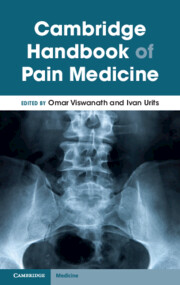Book contents
- Cambridge Handbook of Pain Medicine
- Cambridge Handbook of Pain Medicine
- Copyright page
- Contents
- Contributors
- Pain Handbook Introduction
- Part I Introduction to Pain: Pain Signaling Pathways
- Chapter 1 Central Neuropathic Pain Signaling Pathways
- Chapter 2 Cannabinoids Pain Signaling Pathways
- Chapter 3 The Microbiome and Chronic Pain Syndromes
- Part II Common Categories of Pharmacologic Medications to Treat Chronic Pain
- Part III Chronic Pain Conditions Head and Neck
- Part IV Spine
- Part V Extremities
- Part VI Misc
- Part VII Adjunctive Therapy
- Index
- References
Chapter 1 - Central Neuropathic Pain Signaling Pathways
from Part I - Introduction to Pain: Pain Signaling Pathways
Published online by Cambridge University Press: 01 December 2023
- Cambridge Handbook of Pain Medicine
- Cambridge Handbook of Pain Medicine
- Copyright page
- Contents
- Contributors
- Pain Handbook Introduction
- Part I Introduction to Pain: Pain Signaling Pathways
- Chapter 1 Central Neuropathic Pain Signaling Pathways
- Chapter 2 Cannabinoids Pain Signaling Pathways
- Chapter 3 The Microbiome and Chronic Pain Syndromes
- Part II Common Categories of Pharmacologic Medications to Treat Chronic Pain
- Part III Chronic Pain Conditions Head and Neck
- Part IV Spine
- Part V Extremities
- Part VI Misc
- Part VII Adjunctive Therapy
- Index
- References
Summary
Neuropathic pain (NP) is a common complication of spinal cord injury (SCI) that is difficult to treat. Chronic NP is associated with increased levels of inflammatory mediators and ion channel dysfunction, as well as nerve damage and nerve-glia crosstalk. Recent studies have made headway in identifying novel biomarkers, including microRNA and psycho-social attributes that can predict progress from SCI to chronic NP (CNP). Conventional medical treatment has limited success, but recent studies have identified new biomarkers and promising drugs, such as baclofen and ziconotide, that can provide pain relief. However, further studies are needed to determine the safety profile of these drugs. Nonmedical interventions, such as brain sensitization and biofeedback techniques, have also shown promise in managing CNP. A multidisciplinary approach, including psycho-social support, medical and nonmedical interventions, is necessary to effectively manage CNP in SCI patients.
- Type
- Chapter
- Information
- Cambridge Handbook of Pain Medicine , pp. 3 - 13Publisher: Cambridge University PressPrint publication year: 2023



